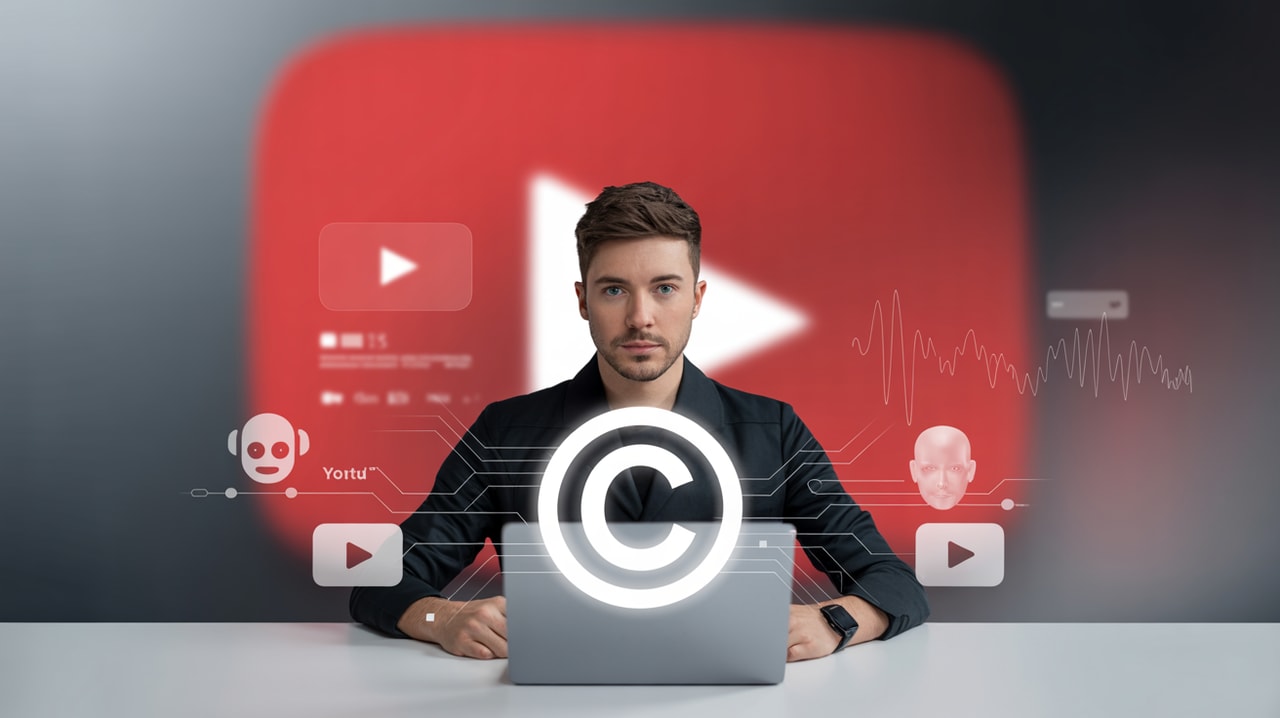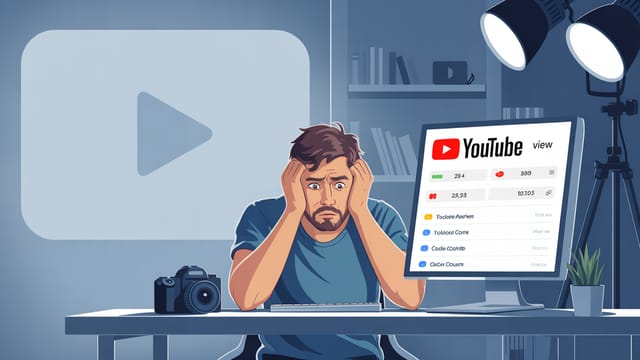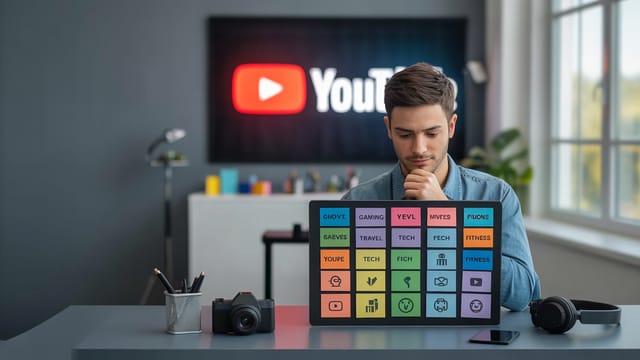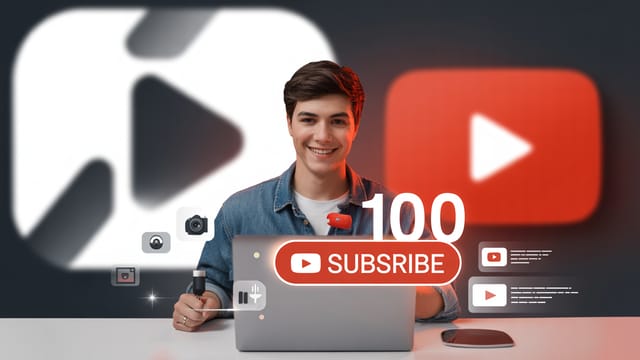
Ready to get your next 10,000 subscribers?
Join thousands of creators who use Subscribr to create faster, better YouTube videos.
Copyright & AI on YouTube: A Creator's Guide to Staying Safe
As AI tools become integral to content creation, from generating music and visuals to drafting scripts, many YouTubers are asking a critical question: What about copyright? The promise of faster creation and new creative possibilities is exciting, but the fear of strikes and legal headaches looms large. Navigating the intersection of AI and copyright on YouTube requires understanding the nuances of how existing copyright law applies to AI-generated content and staying informed about YouTube's evolving policies.
This guide will walk you through the potential copyright pitfalls of using AI-generated assets, explain YouTube's stance, and provide actionable strategies to keep your channel safe while leveraging the power of AI. We'll address common concerns, look at the risks involved, and discuss the ethical considerations that are becoming increasingly important in the AI era.
Can I Use AI-Generated Images in My YouTube Videos Without Copyright Issues?
Using AI-generated images in your YouTube videos introduces a layer of complexity regarding copyright. The core question is: Who owns the copyright to an image created by an AI?
Currently, copyright law in many jurisdictions, including the United States, generally requires human authorship. This means that content purely generated by an AI, without significant human creative input, may not be eligible for copyright protection itself. This doesn't automatically mean AI images are free for anyone to use, however.
The terms of service of the specific AI image generator you use are paramount. Many platforms grant users a license to use the generated images, often for commercial purposes like YouTube videos. However, these licenses can vary wildly. Some might grant full commercial rights, while others might have restrictions. Always read the terms and conditions of the AI tool you are using.
Another consideration is the data the AI was trained on. If an AI is trained on copyrighted images without proper licensing, there's a theoretical risk that the output could be deemed derivative of the training data. While this is a complex legal area that is still being debated and tested, it's a risk to be aware of, particularly if the AI-generated image closely resembles existing copyrighted work.
Best Practices for AI-Generated Images:
- Review Tool Terms: Thoroughly understand the usage rights granted by the AI image generator.
- Aim for Originality: Even with AI, try to guide the generation process to create unique visuals that don't closely mimic existing art.
- Consider Human Edits: Adding significant human creative input through editing or incorporating the AI image into a larger, original visual work can strengthen a claim to copyright in the final piece.
- Maintain Records: Keep records of the prompts you used and the AI tool's output as documentation.
Is AI-Generated Music Safe to Use on YouTube?
The safety of using AI-generated music on YouTube largely depends on the platform used to create the music and its licensing model. As highlighted in our research, AI music tools designed specifically for content creators, like Beatoven, aim to provide music that is copyright-free for use in videos. These platforms typically generate original compositions based on parameters you provide (genre, mood, tempo), and they manage the underlying rights to ensure creators can use the music without worrying about Content ID claims or copyright strikes.
However, not all AI music generators are created equal. Some might generate music that is too similar to existing copyrighted songs, potentially leading to issues. Others might have restrictive licenses that don't permit commercial use on platforms like YouTube.
Risks with AI Music:
- Similarity to Existing Music: Even if the AI is designed to create original music, there's a chance it could unintentionally generate something too close to a copyrighted track, triggering Content ID.
- Unclear Licensing: Using music from platforms with ambiguous or restrictive terms can lead to copyright issues down the line.
- Future Legal Changes: The legal landscape around AI-generated content is still evolving. Future rulings or legislation could impact the status of AI music.
Best Practices for AI-Generated Music:
- Use Creator-Focused Platforms: Opt for AI music generators specifically marketed towards content creators with clear licensing for YouTube.
- Check Terms of Service: Again, the terms are crucial. Ensure commercial use on YouTube is explicitly permitted.
- Listen Critically: Before using a track, listen carefully to ensure it doesn't sound too similar to popular copyrighted music.
- Consider Alternatives: If you're unsure, using royalty-free music from reputable libraries or creating your own music remains the safest option.
What Are the Risks of Using AI Content Regarding Copyright?
Beyond the specifics of images and music, using AI content on YouTube presents broader copyright risks:
- Derivative Works: If your AI-generated content is heavily based on existing copyrighted material (e.g., asking an AI to rewrite a specific movie script or generate images in the exact style of a famous artist), it could be considered a derivative work, infringing on the original copyright holder's rights.
- Content ID Claims: YouTube's Content ID system is designed to detect copyrighted material. While it's still adapting to AI, it could potentially flag AI-generated content that matches existing works, leading to monetization issues or takedowns.
- Misinformation and Deception: YouTube is increasingly concerned about realistic altered or synthetic content that could mislead viewers. Using AI to create deepfakes or alter reality without disclosure can lead to policy violations, which can have consequences similar to copyright strikes.
- Monetization Uncertainty: As noted in the research, the eligibility for monetization for channels heavily reliant on AI-generated content is still an open question for YouTube. The platform is evaluating how to handle channels that lack significant human creative input, and the line for monetization is not yet clearly defined.
It's crucial to remember that while AI is a powerful tool, it doesn't absolve creators of their responsibility to respect copyright and YouTube's community guidelines.
Ethical Considerations and Responsible AI Use on YouTube
Beyond the legal aspects of copyright, using AI on YouTube also raises important ethical considerations. As creators, maintaining transparency and authenticity with your audience is key.
- Transparency: Should you disclose when AI has been used to create parts of your video? YouTube is moving towards requiring disclosure for realistic altered or synthetic content. Even when not strictly required, being transparent builds trust with your viewers.
- Authenticity: While AI can assist with scriptwriting or generating visuals, ensuring your unique voice and perspective shine through is vital for connecting with your audience. Over-reliance on AI can lead to generic, uninspired content.
- Bias in AI: AI models are trained on vast datasets, which can contain biases. This can inadvertently lead to biased or stereotypical content if not carefully managed.
- Impact on Human Creativity: The rise of AI in content creation raises questions about the value of human artistry and labor. Consider the broader impact of your AI usage on the creative community.
YouTube's Evolving Disclosure Requirements:
YouTube is implementing new measures to address realistic altered or synthetic content. Creators will be required to disclose when they have used AI or other tools to create content that could be mistaken for reality. This includes using AI for voice generation that sounds like a real person, or creating realistic but synthetic visuals (like deepfakes). New options will be available during the upload process for creators to indicate the presence of such content. Failing to disclose when required can lead to penalties.
This move by YouTube underscores the platform's commitment to preventing misleading content and highlights the importance of responsible AI use by creators.
Keeping Up with the Rapid Advancements and New Features in AI Technology
The field of AI is evolving at a breakneck pace. New tools, capabilities, and ethical considerations emerge constantly. Staying informed is crucial for navigating the intersection of AI and YouTube safely and effectively.
- Follow Industry News: Keep up with news from AI research labs, tech companies, and platforms like YouTube regarding AI policies and capabilities.
- Experiment Cautiously: Explore new AI tools, but do so with an understanding of the potential risks and limitations, especially concerning copyright and terms of service.
- Engage with the Creator Community: Discuss AI usage and its implications with other YouTubers. Share knowledge and best practices.
- Utilize Resources: Platforms designed for creators, like Subscribr, can help you stay ahead by integrating AI-powered workflows and providing insights into content trends. Subscribr's AI Chat and Research Assistant can help you quickly find information on new AI tools and their potential uses and limitations for YouTube.
Navigating Copyright Issues and Ethical Dilemmas with AI-Generated Content
Addressing the pain points of navigating AI copyright and ethical dilemmas requires a proactive approach.
- Understand the Tools You Use: Deeply understand the terms of service and capabilities of any AI tool you incorporate into your workflow.
- Prioritize Originality: Use AI as a co-pilot, not an autopilot. Focus on using AI to enhance your unique ideas and creative vision, rather than simply generating content.
- Disclose When Necessary: Err on the side of transparency, especially with realistic AI-generated elements.
- Stay Informed on Policies: Keep up with YouTube's official announcements and guidelines regarding AI-generated content and disclosure requirements.
- Seek Legal Counsel When Needed: For complex situations or significant concerns about copyright, consulting with a legal professional specializing in intellectual property is the safest course of action. Navigating the legal landscape of AI is new territory, and expert advice can be invaluable.
AI-Driven Content Creation: Scripts, Visuals, Voice, and Music
AI is revolutionizing various aspects of content creation:
- Scripts: AI models can help brainstorm ideas, generate outlines, and even draft sections of scripts. Tools within a platform like Subscribr's AI Script Writer are trained to understand YouTube content structures, helping you go from idea to draft efficiently. However, human editing is essential to inject your personality and refine the narrative. Avoid simply prompting an AI to replicate a competitor's script; instead, use it to explore angles and refine your own unique take.
- Visuals: AI image and video generators can create unique graphics, backgrounds, or even short video clips. These can be powerful additions, but remember the copyright considerations discussed earlier.
- Voice: AI voice cloning and text-to-speech tools allow creators to generate voiceovers. This can be useful for efficiency, but be mindful of the ethical implications and YouTube's disclosure requirements, especially if creating a realistic voice clone.
- Music: As explored, AI music generators can provide background tracks. Using platforms with clear YouTube licensing is crucial.
Subscribr's comprehensive platform supports AI-driven content creation by providing tools like the AI Script Writer, Research Assistant for gathering information (including on AI tools), and features that help refine your content's voice and structure, enabling you to leverage AI responsibly within your workflow.
Monetization and AI Content
The question of whether channels primarily using AI-generated elements can qualify for YouTube monetization is still being determined. YouTube's Partner Program requires channels to meet certain standards, and how AI-heavy content fits into these standards is an ongoing discussion.
YouTube views AI as a tool, similar to editing software. However, the extent to which a channel relies on AI versus human creativity will likely be a factor. Channels that simply automate content creation without significant human input or unique value may face challenges with monetization.
Focusing on creating high-quality, engaging content that provides value to your audience, regardless of the tools you use, remains the best strategy for monetization. If you utilize AI, ensure it enhances your content and creative process rather than replacing genuine human effort and originality.
Best Practices for Creators Using AI
Here's a summary of best practices for creators incorporating AI into their YouTube workflow:
- Understand Copyright Basics: Familiarize yourself with how copyright applies to creative works.
- Vet Your AI Tools: Carefully review the terms of service and licensing for all AI tools you use, especially for commercially used assets like music and visuals.
- Focus on Human Creativity: Use AI as a tool to assist and enhance your creative process, not replace it entirely. Your unique voice and perspective are your most valuable assets.
- Disclose When Required: Follow YouTube's guidelines on disclosing realistic altered or synthetic content.
- Stay Updated: Keep informed about the latest developments in AI technology and YouTube's policies.
- Prioritize Value and Engagement: Create content that is valuable, engaging, and provides a positive experience for your viewers. This is the most reliable path to success on YouTube.
Tools & Resources
Navigating the complexities of AI and copyright on YouTube is an ongoing process. Utilizing platforms like Subscribr can provide valuable support. Subscribr offers tools like the AI Script Writer, Research Assistant, and Channel Intelligence that can help you create content more efficiently while staying informed.
For legal guidance on specific copyright concerns related to AI, consider consulting with an intellectual property lawyer. As the legal landscape evolves, professional advice is often necessary.
To help creators stay compliant and navigate the ethical considerations, a comprehensive checklist for AI content compliance can be a valuable resource. This could cover reviewing tool terms, documenting AI usage, and ensuring necessary disclosures are made.
Conclusion
AI offers incredible potential for YouTube creators, streamlining workflows and unlocking new creative possibilities. However, responsible use is paramount. By understanding the current copyright landscape, staying informed about YouTube's evolving policies, and prioritizing ethical considerations and transparency, you can leverage AI's power while protecting your channel from potential issues. Focus on using AI to enhance your unique creative vision and deliver exceptional value to your audience. The future of AI on YouTube is bright for creators who navigate it wisely and responsibly.





